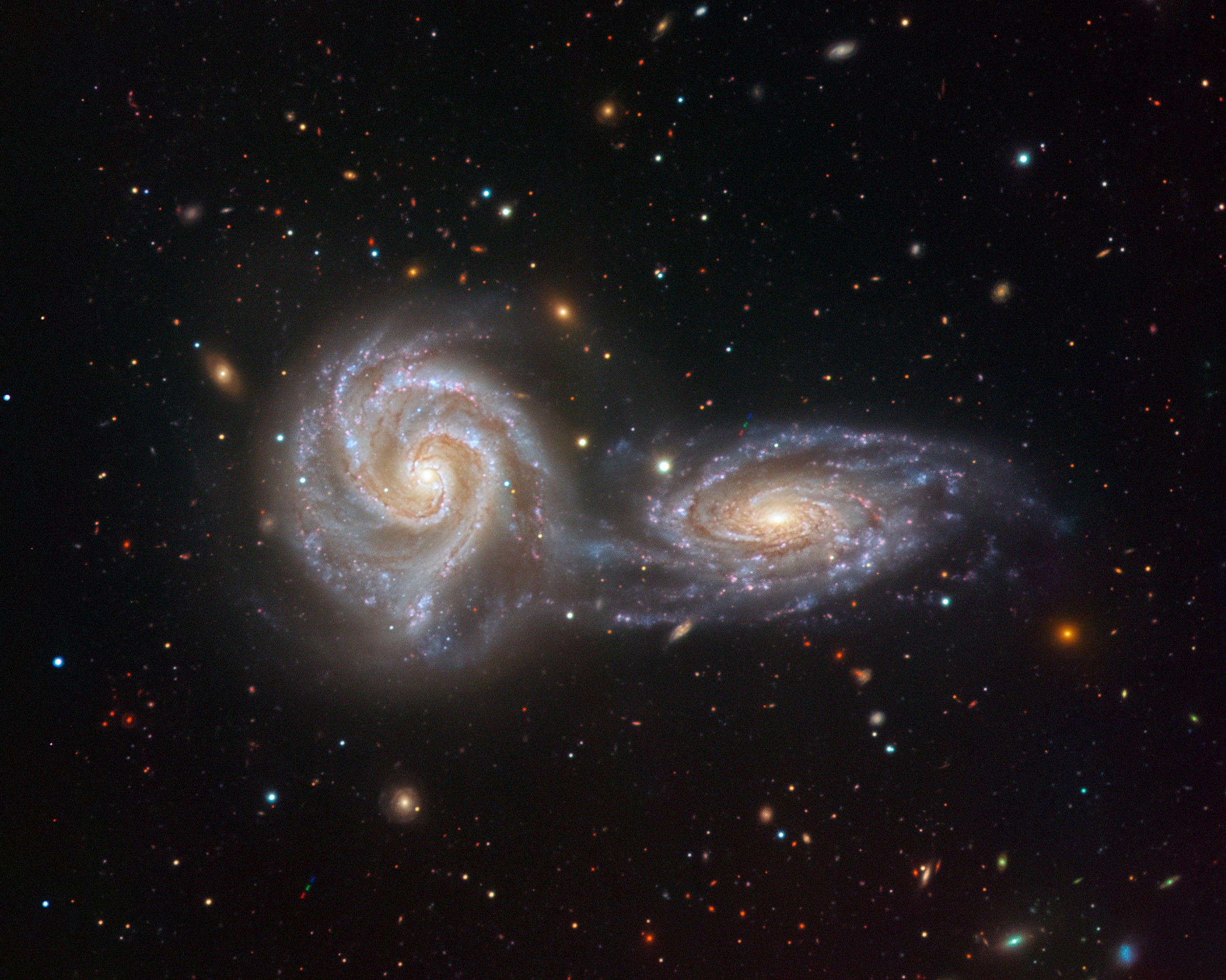Create a free profile to get unlimited access to exclusive videos, sweepstakes, and more!
Will they or won't they? Two galaxies that probably won't become one

I've always been fascinated by interacting galaxies.
Part of that is simply the scale. Galaxies are immense structures. When you go outside at night and look up, you can see a few thousand stars. Almost all of them are relatively close to the Sun, with the vast majority being less than 1,000 light years away. But the Milky Way is 100,000 light years across! The stars you see with your naked eye seem countless, but they represent about one one-hundred-millionth of all the stars in the galaxy.
Galaxies are flippin' huge.
And because they're so big they sometimes get close to other galaxies in space, passing each other as they move along in the Universe. When they do, all sorts of interesting things can happen. The gravity of one affects the other, which can distort their shapes, draw out long, thin streams of gas and stars (called tidal tails), affect their rotations, and (in the case of spiral galaxies) affect the way their spiral arms behave, triggering star formation.
These are all such vast effects splaying out on cosmic timescales that, when I try to grasp them with my puny human meatbrain, I can get vapor locked. To be honest, I love that feeling. The Universe is awe-inspiring.
But there's another reason I love interacting galaxies. They're gorgeous.
Meet Arp 271, the collective name for two galaxies that have just started this long, long dance*:
This lovely image was taken using the Very Large Telescope, an 8.2-meter behemoth in Chile. The camera used is called the VIsible Multi-Object Spectrograph (or VIMOS), which has been used on the VLT for 18 years, but was recently decommissioned as better, more modern detectors have come online.
As you can see, VIMOS did a fantastic job! †
The two individual galaxies are called NGC 5427 (the more face-on one on the left) and NGC 5426 (the more edge-on one on the right), and they’re located about 100 million light years from us. Each is large (nearly the same size as the Milky Way) and about the same mass as each other (though NGC 5426 is probably slightly heftier).
It's not clear what distance separates the two from each other; when we get an image like this we lose the perception of depth. They could be separated by less than one galaxy diameter, or they may be in fact quite distant. But there are clues in the image that they are relatively close.
For example, there are a couple of "tidal bridges," streamers connecting the two. Those are created when two galaxies pass close enough to affect each other. Also, observations using a camera on a 2.1-meter telescope at the Observatorio Astronomico Nacional in Mexico have shown that the motions of the stars in each galaxy are disrupted past a certain distance from the center of each. In an isolated galaxy, the stars on one side of the galaxy should be moving at the same speed as on the other side (in other words, the galaxy is symmetric). The observations from OANM show that stars in either galaxy closer in than about 30,000 light years show symmetry, but outside that get thrown off. The gravity of one galaxy is distorting the orbits of the outer stars in the other.
Subtle analysis of those observations indicates NGC 5427 is behind NGC 5426 from our point of view and is swinging around the slightly more massive galaxy toward the right. It also implies they've been interacting over the past 100 million years or so. Given all that, plus the fact that the galaxies are not hugely distorted — some interactions can really play havoc with structure — it looks like these two will pass each other without an actual collision.
Which does happen! Depending on the circumstances, galaxies that collide can merge, forming a single much larger galaxy. That won't happen with these two, but it'll happen to us. In something like four billion years, the Milky Way will collide with the Andromeda Galaxy, another spiral with roughly the same size and mass as we have. When that happens (after at least one encounter where they pass each other, then swing around again for a second, final dance) the two huge galaxies will merge, forming one even more massiver galaxy.
Andromeda is about 2.5 million light years away. But at some point, when it's maybe 100,000 or 200,000 light years out, the two of us will look much like the pair in Arp 271. So take a good look at that image. Those two may pass relatively unscathed. Our future will be very, very different.
*Halton Arp was an astronomer who catalogued peculiar galaxies, including many that have been caught in various collisional stages in flagrante delicto… which literally means "in blazing offense," so in fact is an apt metaphor. So oddly, in his catalog you can have two or more galaxies with a single designation, like Arp 271, while each galaxy might have its own name in other catalogs, like the New General Catalog (NGC).
†Take another look at that image. Can you find an asteroid in it? Look just above the center of NGC 5426 at the outskirts of the arms. See the blue/green/red streak? That's likely an asteroid in our solar system moving through the frame, and appears as different colors due to different filters being used to make this "natural color" image. I spotted a similar thing in another image of a galaxy taken with VLT and describe it in detail there.















